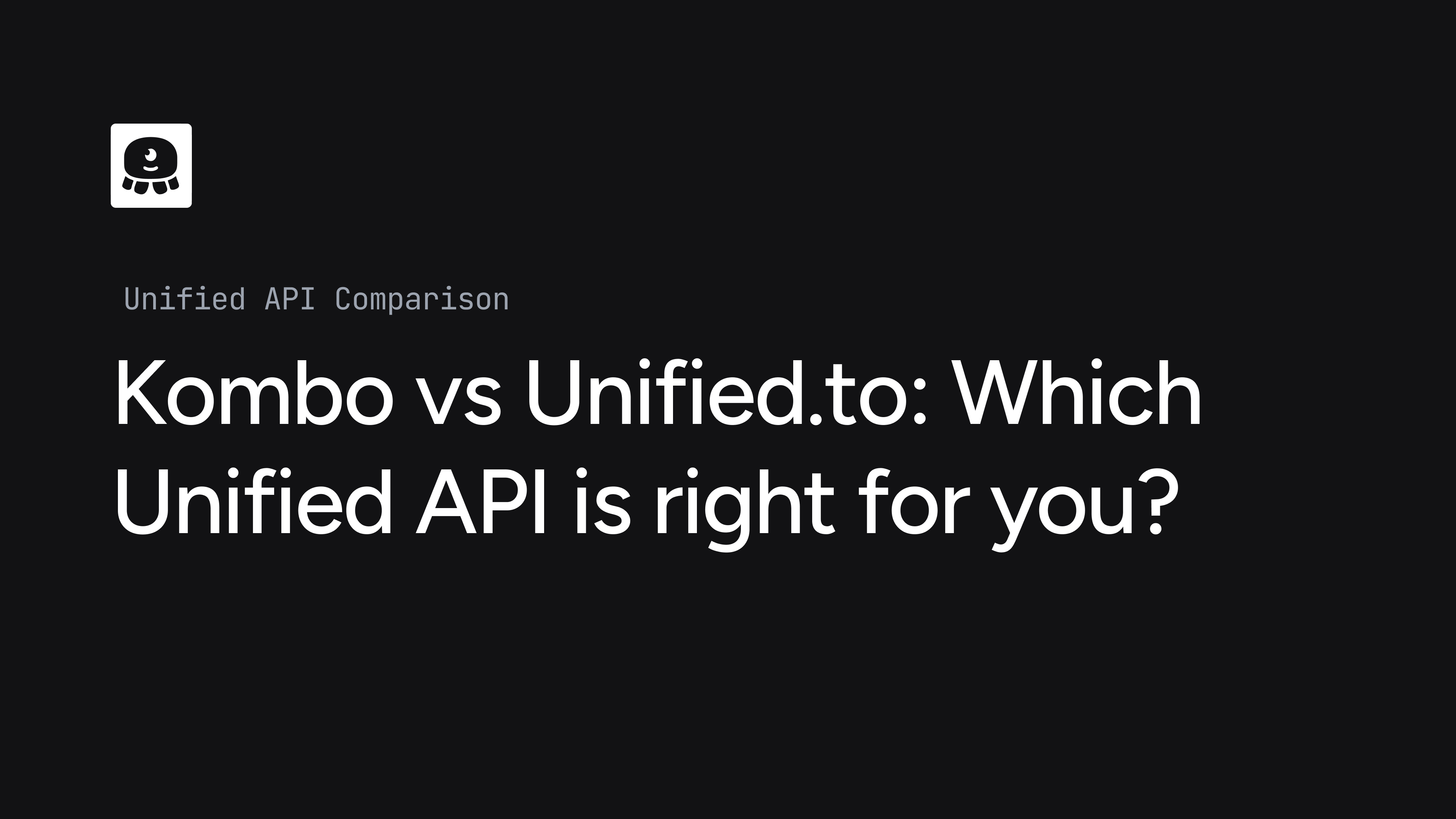Kombo vs. Unified.to: w
June 4, 2025

Kombo is purpose-built for integrating HR, ATS, and payroll systems. Unified.to goes broader—delivering real-time, AI-ready data from 270+ APIs across 20 categories, including deep support for HR and recruiting platforms.
If you're building within HR tech, Kombo is deep and well-scoped. But if your product needs clean, fresh data across HR, CRM, and business systems—Unified.to gives you more breadth, less latency, and zero storage risk.
At a glance: Unified.to vs Kombo
Kombo offers deep HR coverage. Unified.to supports real-time, cross-domain pipelines with normalized schemas and no data storage.
Unified.to gives you:
- Real-time updates (native + virtual webhooks)
- 270+ integrations across HR, CRM, ATS, Support, Marketing, and more
- Normalized schemas with passthrough + raw field support
- Database sync to Postgres, Mongo, MySQL
- Zero-data architecture: no stored tokens or payloads
- GenAI-ready tools: structured context for copilots and RAG
HR depth vs SaaS-wide breadth
Kombo focuses on HR tech: HRIS, ATS, and Payroll. It offers solid schemas and fast integration delivery inside that niche.
Unified.to supports 270+ APIs across 20 software categories:
- HR (e.g., Workday, Personio, BambooHR, Gusto, ADP, HiBob, SAP SuccessFactors)
- ATS (e.g., Greenhouse, Lever, Ashby, Workable, JobAdder, SmartRecruiters)
- CRM, Support, Repos, File Storage, Calendar, and more
You get one platform for customer, employee, and system data—streamed in real time.
Real-time by design
Kombo polls source systems every few hours and stores data in its own database. It sends webhooks when batch syncs complete.
Unified.to is event-driven:
- Native webhooks when available
- Virtual webhooks for APIs without events
- You get immediate updates via push—not polling jobs
Webhooks are configurable by object, field, and interval. You get structured events when data changes.
AI-native foundation
Kombo provides HR data to downstream AI workflows, but lacks native AI features.
Unified.to is designed for AI-native SaaS:
- GenAI category with prompt/model objects
- RAG-ready: pull context in real time from multiple APIs
- Stream to LLMs, vector stores, or dashboards
Fresh, structured, cross-domain data for copilots and agents.
No data stored
Kombo mirrors customer data into its own infra. Raw data access requires enabling storage of unnormalized payloads—which can include PII.
Unified.to stores nothing:
- No payloads or tokens cached
- Credentials can live in your AWS Secrets Manager
- Complies with data minimization principles
A leaner surface area for compliance-conscious teams.
Developer experience
Both platforms offer solid docs, SDKs, and a sandbox. Kombo provides a mock integration and "Kombo Connect" for auth.
Unified.to adds:
- Declarative API + OpenAPI schemas
- Fine-grained webhook config
- Sandbox + tester account
- Passthrough support and normalized schemas across every category
Faster time to value. More consistency across APIs.
TL;DR — Unified.to vs Kombo
| Feature | Unified.to | Kombo |
|---|---|---|
| Integration focus | 270+ APIs across 20 categories | HRIS, ATS, and Payroll only |
| Real-time support | Native + virtual webhooks (event-driven) | Polling + batch webhooks |
| Schema model | Normalized across domains + passthrough/raw | Normalized HR schema + raw access |
| Database delivery | Built-in DB sync to Postgres, Mongo, etc. | Batch syncs; user fetch after webhook |
| AI readiness | GenAI category, RAG-ready, real-time agents | Indirect AI use via HR data |
| Data storage | Zero-data architecture | Stores customer data (configurable) |
| Developer experience | SDKs, sandbox, real-time webhooks, OpenAPI | SDKs, sandbox, Kombo Connect UI |
| Best for | AI-native apps with multi-domain data needs | HR-focused SaaS with deep HRIS logic |
If you're building HR-specific features and don't need real-time, Kombo is strong.
But if you're shipping AI-native SaaS and need immediate access to structured data across business systems—Unified.to is built for it.
Try Unified.to free for 30 days or book a demo to move faster with live integrations.
